|
In the early 1960s, the philosopher
Hubert Dreyfus started to formulate his objections to
the then-predominant school of Artificial Intelligence
research. Based on his knowledge of phenomenology,
especially derived from Heidegger and Merleau-Ponty, he
introduced a series of disagreements on the assumptions
which the early AI researchers had taken as their
premise.
At the height of blind optimism for
what computers would be able to do in the near future,
the AI scientific community ignored Dreyfus' critique
with ridicule and at times with hostility. However, the
complexity of the human mind proved to be more
unpredictable than these AI researchers had anticipated.
By the 1980s many of Dreyfus' perspectives had been
rediscovered by researchers of robotics, and by the
early 1990s several of his radical opinions had become
more or less mainstream. "[T]ime has proven the accuracy
and perceptiveness of some of Dreyfus's comments"(Daniel
Crevier: Historian and AI researcher). (1)
Serving as an anecdote, this story
highlights the narrow-mindedness and even arrogant
self-righteousness that the mainstream hegemony exhibits
at times. It also witnesses the invincibility of human
complexity which emphasises that such oddness and
incorrectness, rather than expertise of a straight path,
can sometimes provide an answer closer to the truth.
Cross-examination and re-evaluation of values from
various perspectives seem not to be a burden but an
asset that enriches human thought processes.
In many ways Fylkingen(2)
symbolises the very space in which this enrichment of
cross-field fertilisation can occur in a natural organic
way. With members from vastly different backgrounds,
Fylkingen has over the years been a unique meeting place
for various art practices in Sweden, often
yet-to-be-established and yet-to-be-defined. This
richness is hopefully reflected in Fylkingen's online
journal Hz, for which I have served as its
editor since 2003.
Fylkingen Bulletin and
International Bulletin
Hz's history begins in the 1990s, when
Fylkingen, on the initiative of Carl
Michael von Hausswolff and Bo
Rydberg, published the then-non-virtual magazine
Hz in 1992. The intention was to revive the tradition of
Fylkingen's own journal Fylkingen Bulletin.
Fylkingen Bulletin had been in circulation between
1966–69, the purpose of which was explained in its first
issue as follows: "The aim of this publication is to
disseminate ideas which are developed or supported by
Fylkingen; discuss that part of reality which primarily
concerns emotions, needs and evaluations in
technologically-advanced societies; establish a stronger
integration between art, research and culture planning;
inform artists about possibilities offered by modern
science and technology."(3)
Fylkingen Bulletin reflects the unique
position Fylkingen held during the 1960s: namely,
Internationalism and Technology. Already in its first
issue, a translation of John Cage's text "Diary: How to
Improve the World (You Will Only Make Matters Worse)"
from 1965 was included.
 |
|
John Cage during
"Variations II" at a Fylkingen
concert, 1963. Photo: Stig A. Nilsson.
Appeared in the first issue of
Fylkingen Bulletin (1:1966)
|
|
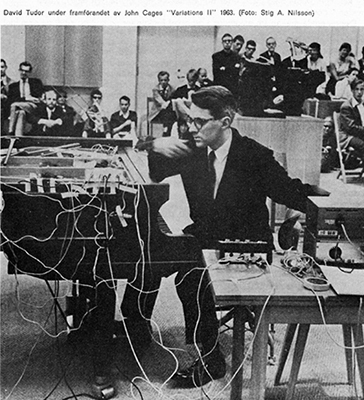 |
|
David Tudor performing
John Cage's "Variations II" at a
Fylkingen concert, 1963. Photo: Stig
A. Nilsson. Appeared in the first
issue of Fylkingen Bulletin (1:1966)
|
|
 |
|
Nam June Paik at a
Fylkingen Concert at Liljevalchs,
Stockholm, 1961. Photo: Lütfi Özkök.
Appeared in the first issue of
Fylkingen Bulletin (1:1966)
|
|
 |
|
A still picture from
Robert Morris' "Site" at a Fylkingen
performance, 3 September, 1965.
Included in both Fylkingen Bulletin
1:1966 and International Bulletin
1:1967. Although the English caption
from the 1:1967 reads "11 September
1964," after consultating the list of
concerts in Fylkingen Bulletin 1:1966,
the Swedish caption "1965" (in
Bulletin 1:1966) appears most
accurate.
|
|
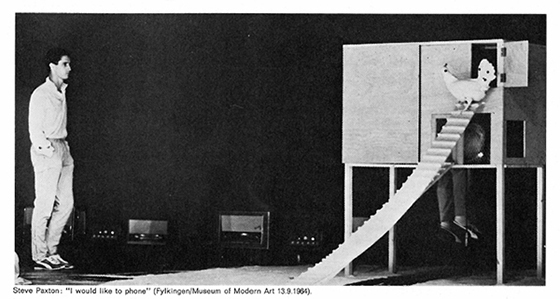 |
|
A still picture from
Steve Paxton's "I would like to phone"
at a Fylkingen performance at the
Museum of Modern Art, Stockholm, 13
September 1964. Included in Fylkingen
Bulletin 1:1966 and Fylkingen
International Bulletin 1:1967. Photo:
10 fotografer
|
|
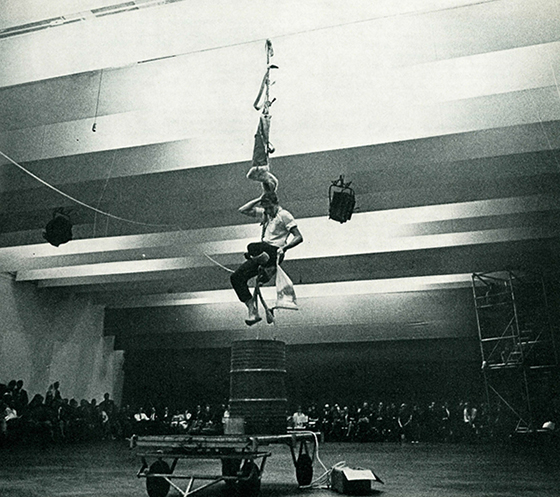 |
|
Robert Rauschenberg
performing "Shotput + Elgin Tie" at a
Fylkingen concert at the Museum of
Modern Art, Stockholm, 13 September
1964. From Fylkingen Bulletin 1:1966.
Photo: Hans Malmberg/Tio
|
|
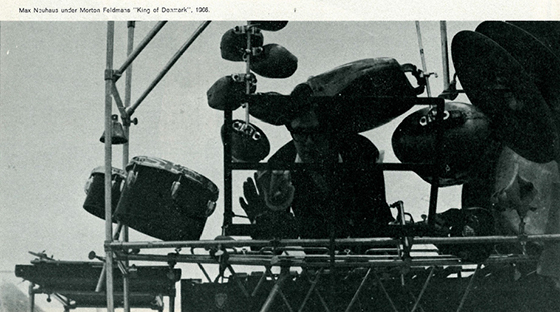 |
|
Max Neuhaus, who later
became one of the pioneers in sound
art, here photographed performing
Morton Feldman's "King of Denmark" as
a percussionist. At a Fylkingen
concert, 28 January, 1966. From
Fylkingen Bulletin 1:1966.
|
|
Closely entangled with this
internationalism was Fylkingen's concern with new
technology in art of that period. Starting with Knut
Wiggen's "Memorandum 1965" which declared "the
foundation for Fylkingen to engage in 'Art &
Technology' problematics,"(4)
Bulletin's second issue (1:1967) was a result of
Fylkingen's legendary festival "Visions of the Present"
that had taken place at the Swedish National Museum of
Science and Technology the previous year. Presented in
the issue were the texts by the festival participants
who examined the theme from various fields: John R.
Pierce/engineer and information theorist at Bell Labs
(USA), Sven Fagerberg/author (SE), Anthony Hill/visual
artist (UK), Oscar Hansen/architect (PL), Carl
Lesche/philosopher of science (FI/SE), and Yonda
Friedman/architect (HU). This issue also led to the
birth of another publication, Fylkingen
International Bulletin, which published the same
content in French and English under the subtitle Stockholm
Festival on Art and Technology I. A later
publication from the same year, Fylkingen Bulletin
International (2:1967) with its subtitle Stockholm
Festival on Art and Technology II, was a
multi-lingual publication, in which the original texts
by the 1966 festival participants, Iannis Xenakis, Nam
June Paik, Alvin Lucier, Kostas Axelos and Gunnar
Hellström, were complemented with Pierre Schaeffer's
"Musique et acoustique," and all the texts in foreign
languages translated to Swedish and vice versa.(5)
Fylkingen International Bulletin
continued publishing texts in French and English, whilst
Fylkingen Bulletin continued in Swedish. In total,
between 1966 and 1969 Fylkingen published seven
Bulletins, three International Bulletins and one
combined. Although some individual articles appeared in
both Bulletin and International Bulletin, except for the
above examples from 1967, no issues between the two
publications were identical in their content.
 |
|
John R. Pierce from
Bell Telephone Laboratories whose
article "Science, Technology and Art"
appears in Fylkingen International
Bulletin 1:1967 and Fylkingen Bulletin
1:1967.
|
|
 |
|
This
today-legendarily-famous picture
(called "Nude") by Ken Knowlton and
Leon Harmon from Bell Labs (1966)
appears on p. 18, within the article
"Sceience, Technology and Art" by John
R. Pierce, in Fylkingen International
Bulletin 1:1967, and on p. 11 in
Fylkigen Bulletin 1:1967. No credit
nor caption is inserted.
|
|
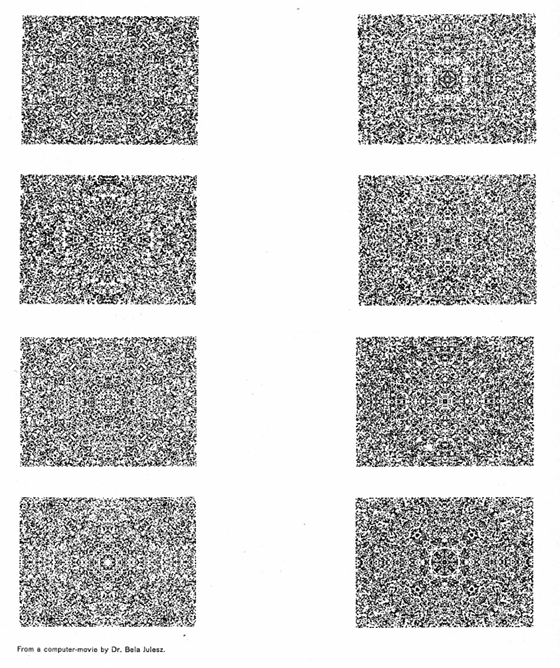 |
|
Stills from a
computer-movie by Dr. Bela Julesz of
Bell Labs, found within Pierces'
article "Science, Technology and Art"
in Fylkingen International Bulletin
1:1967 and Fylkingen Bulletin 1:1967.
|
|
It is worth mentioning that two other
texts by Schaeffer are to be found in Bulletin. In the
second issue of 1968, Bulletin introduced "Machines for
Communicating" (translated to Swedish as
"Kommunikationsmaskiner"), a reprint of the lecture held
by Pierre Schaeffer in Stockholm on 13 March, 1968. Note
that the year of publication for this article is dated
two years prior to the publication of the first volume
of Machines à communiquer (Machines for
Communicating). While this most probably depended
on the fact that "[t]his first volume, which was given
the subtitle Genèse des simulacres [(Genesis
of Simulacra)], consisted of several essays and
articles that Schaeffer had published over the years"(6),
it demonstrates yet another example of Fylkingen's
competence in evaluating relevant contemporary knowledge
and information. Also included in the same number was
the first chapter of La musique concrète, "Que
sais-je?" (translated to Swedish as "Det konkreta
äventyret"). The latter was to be reprinted 24 years
later in Hz's first issue.
Bulletin and International Bulletin
from the 1960s are not only ambitiously up-to-date
periodicals of their time but also a testimony to the
uniqueness and importance of Fylkingen as a society in
Swedish art history. Bulletin resurfaced in 1983 in
conjunction with Fylkingen's 50th anniversary but this
edition was to be the last. In 1992 Fylkingen introduced
its successor Hz.
Hz: Fylkingens Bulletin
The non-virtual Hz was, as its subtitle
Fylkingens Bulletin indicated, an undertaking
to revive Fylkingen's own journal. However, its
intention was radically different from its predecessor:
"[Hz-] Bulletin aims to spread information on Fylkingen
and the activities of its members."(7)
Hz's format, one single A2 sheet of paper folded into
A4, also revealed a departure from Fylkingen Bulletin.
Containing two to three articles in each number, Hz's
bulletin could be literally posted on a bulletin board
like a poster, and if posted with the front and back
pages of the same number together, the whole issue could
be read on the spot, even on a city street. It could
also be taken aboard to be read on the seat of a tube
train, in a much easier manner than Metro, the freesheet
newspaper for commuters that came into existence in
Stockholm three years later. This adaptation to our
modern living is not only clever but also probably the
strongest achievement of Hz, which, through its design,
sets its profile apart from other publications from the
same period. Content-wise, each number consisted of one
to two articles, an announcement of activities of
Fylkingen, and juxtaposed with them one historical
article, such as the aforementioned Pierre Schaeffer,
Luigi Russolo or Dom Sylvester Houédard, which together
revealed historical threads within the society's
activities.
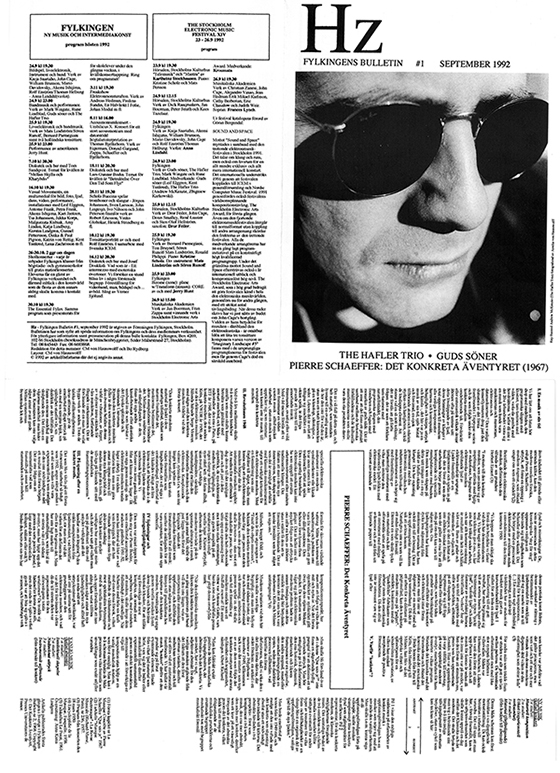 |
|
A2 format of Hz, when
unfolded completely from A4.
Hz's front (upper right) & back
(upper left) pages when folded to A4.
Unfolded from A4 to A3, the bottom
half becomes its first opened page.
Furthermore when unfolded completely
to A2, this becomes the back side of
Hz's "inside pages" as below.
|
|
 |
|
Hz's "inside pages."
When unfolded completely, i.e. to its
largest size A2, these two pages
appears almost as a center spread.
|
|
|
The first number of Hz from
1992. A single sheet of hard paper of size A2
folded into A4 to be unfolded and read in
different sizes: a format that persisted
throughout all three non-virtual issues
between 1992 and 1993.
|
Hz-Journal (Online Hz)
The keen awareness of our time has
always been one of Fylkingen's strong assets, and Hz's
move into the online arena in 2000, an initiative taken
by Thomas
Liljenberg after three issues of non-virtual
publication, was no exception. Hz adopted in 2003 the
domain name hz-journal.org as well as Fylkingen's
Net Journal as its description. Since the online
No.3, in order to adapt further to the global
perspective of our time, the content of Hz has been
intentionally redirected to the areas of interests of
Fylkingen members rather than based on Fylkingen as a
venue. To compensate this shift, Fylkingen's history and
its significance was introduced in the informative
article "Fylkingen.org:
Visions of the Present in Retrospect" in No.4 in
2004, written by Teddy
Hultberg in conjunction with Fylkingen's 70th
anniversary.
With new possibilities the Internet
brings, the present Hz (hereafter Hz-Journal
to distinguish from the non-virtual Hz) is
intended to serve as a forum for both national and
international practitioners of yet-to-be-established art
forms to share thoughts and ideas that originate from
their pursuit of art practices. This first priority is
complemented with articles by theorists, critics, and
curators, whose fields of main interest correspond to
the above position. The range of articles stretches from
such rarities within Hz-Journal's context as Photo
Essays, on Black US Performance Art, Identity, and
Manga, to more common Hz-content on EAM, Sound Art,
Audio-Visual Performance, Game, Virtual World, Social
Web, etc.(8)
Between 2003 and 2009 it also included Net Gallery where
international net artworks were introduced.(9)
It is my intention that Hz-Journal,
with a focus on sharing, gives room for
in-depth texts by resisting reporting journalism,
reviews, art criticism, or texts with political
intentions. As such, it has been able to publish texts
of a more philosophical nature as well as to reprint MA
theses, book chapters, and such earlier published
milestone texts as Kim Cascone's "The
Aesthetics of Failure: 'Post-Digital' Tendencies in
Contemporary Computer Music" (No.3:2003), Pauline
Oliveros' "Quantum
Improvisation: The Cybernetic Improvisation"
(No.16:2011), and Roy Ascott's "Moistmedia,
Technoetics and the Three VRs" (No.16:2011).
Another important aspect of Hz-Journal is that, instead
of aiming at highly specialised discourses within a
particular genre based on scientific alternatively
academic merits, it proposes various individual
perspectives within the fields of concern. Hz-Journal
can therefore be read as a trace of those human thoughts
and activities.
Receiving roughly 4000 readers per
year, the demography of readers of Hz-Journal is
literally spread all over the world. Out of 61 countries
that visited the site between 23 August–11 November
2012, 27 % came from USA, followed by 26% from Sweden.
Another 26 % consisted of other European countries, and
the rest comprised Canada, Australia, South Africa, and
countries from the Middle East, Asia and Latin America.
Over the years Hz-Journal has also been linked from
several universities in USA and Sweden as reference
literature for their students.
By engaging aesthetic discussions
relevant to our time, my hope for Hz-Journal is to
continue Fylkingen's tradition of playing the role of
cutting-edge interface between the artists of Sweden and
those abroad.
Thanks to Jan W. Morthenson,
Lars-Gunnar Bodin, Teddy Hultberg, Bill
Brunson, Sten Hanson, Carl Michael von
Hausswolff, Bo Rydberg and Thomas Liljenberg
for providing me with valuable information
as well as verifying some facts in this
article. |
Sachiko Hayashi, November 2012
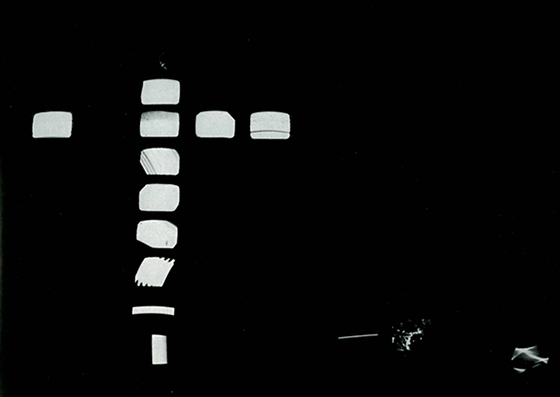 |
|
Arrangement of TV-sets
by Nam June Paik at Fylkingen in 1966,
included in Fylkigen Bulletin
International 1967:2
|
|
 |
|
Anthony Hill's "Relief
Construction" 1965, in Fylkigen
International Bulletin 1967:1. The
caption continues to read: "Courtesy
Kasmin Gallery, London (Photograph:
Hugh Gordon)."
|
|
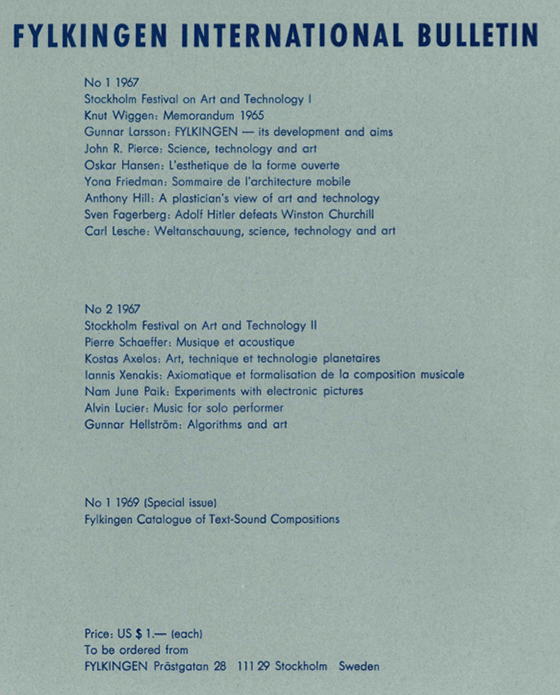 |
|
An ad which appeared in
the 1968:1 issue of Fylkingen
International Bulletin, listing three
previous issues. A complete list of
Fylkingen Bulletin & International
Bulletin publications can be found at
www.hz-journal.org/historical
|
|
|
|
|
An ad in three
different languages, each on a
separate page, calling for
participation of informed artists,
scientists and technicians. Fylkingen
Bulletin International (1967:2).
|
|
|
|
NOTES
(1) ^
"Hubert Dreyfus's views on artificial intelligence." (http://en.wikipedia.org/wiki/Hubert_Dreyfus's_views_on_artificial_intelligence)
Wikipedia: The Free Encyclopedia. Wikimedia
Foundation, Inc. Retrieved 20 July, 2012.
(2) ^
Fylkingen is a non-profit art and music society in
Stockholm. Established in 1933, Fylkingen has been known
for introducing yet-to-be-established art forms
throughout its history. Nam June Paik, Stockhausen,
Cage, Stelarc, etc. have all been introduced to the
Swedish audience through Fylkingen. Its members consist
of leading composers, musicians, sound artists, dancers,
performance artists and video artists in Sweden. This
journal Hz is also published by Fylkingen. For more
information on Fylkingen, please visit: http://fylkingen.se/about
and http://hz-journal.org/n4/hultberg.html
(3) ^
In Swedish: "denna tidskrift vill sprida ideer som
utvecklas och undersföds av fylkingen; belysa den del av
verkligheten som främst omfattar känslor, behov och
värderingar i en teknologiskt avancerad tid; skapa en
ökad integration mellan konst, forskning och
kulturplanering;informera konstnärer om de nya
möjligheter som modern vetenskap och teknik kan
erbjuda." (Fykingen Bulletin 1966:1) The English
translation here is the one which appears in Fylkingen
International Bulletin 1967:1.
(4)
^ See Wiggen
"Memorandum 1965." Swedish version in Fylkingen
Bulletin 1967:1 pp. 2-4 and its English version in
Fylkingen International Bulletin 1967:1 pp. 2-4. In
both versions, there is a-page-long introductory text
prior to the article. This prologue text explains
Fylkingen's engagement with Art & Technology in
the form of an international festival, a decision
taken in fall of 1965 and realised one year later, in
September 1966.
(5)
^ List of
Fylkingen's historical journals (1966-1993) and their
article titles can be found at:http://hz-journal.org/historical/
(6) ^
Ieven, Bram. "Pierre Schaeffer and the Medium of
Modernism" (http://bramieven.org/post/41862736672/pierre-schaeffer-and-the-medium-of-modernism)
Accessed 27 June, 2014.
(7) ^
Description found in all three issues of the non-virtual
Hz.
(8) ^
Hz's back numbers can be found at http://hz-journal.org/bn.html.
The articles published on Hz can also be found through
its article directory at http://hz-journal.org/atcl.html
(9) ^
Some notable artists who have been introduced via Hz Net
Gallery are: MOUCHETTE, jimpunk, Stanza, David Clark,
Annie Abrahams, only to name a few. The complete list of
works introduced in Hz Net Gallery can be found at: http://hz-journal.org/netg/gF.html
Hz Net Gallery should be seen as a continuation of
my effort to introduce the practice of net art to a
wider audience, which had started four years earlier as
the founder and producer of DIAN (Digital Interactive
Artists' Network) while still being an art student. DIAN
came to be listed at and linked from Whitney Museum's
Artport at one point, which continued for some ten years
until the update of their website in recent years.
List of Fylkingen's historical
journals (1966-1993):http://hz-journal.org/historical/
Back numbers of online Hz-Journal:
http://hz-journal.org/bn.html
Hz article directory at http://hz-journal.org/atcl.html
|

![]() where no other claim is indicated.
where no other claim is indicated.
![]() where no other claim is indicated.
where no other claim is indicated.